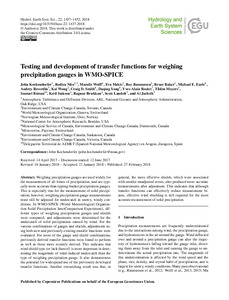Por favor, use este identificador para citar o enlazar este ítem:
http://hdl.handle.net/20.500.11765/11182
Testing and development of transfer functions for weighing precipitation gauges in WMO-SPICE
| Título : | Testing and development of transfer functions for weighing precipitation gauges in WMO-SPICE |
| Autor : | Kochendorfer, John; Nitu, Rodica; Wolff, Mareile; Mekis, Eva; Rasmussen, Roy; Baker, Bruce; Earle, Michael E.; Reverdin, Audrey; Wong, Kai; Smith, Craig D.; Yang, Daqing; Roulet, Yves-Alain; Meyers, Tilden; Buisán Sanz, Samuel Tomás



|
| Palabras clave : | Precipitation measurements; Spatial variability; Gauge; Precipitation |
| Fecha de publicación : | 2018 |
| Editor: | European Geosciences Union |
| Citación : | Hydrology and Earth System Sciences. 2018, 22(2), p. 1437–1452 |
| Versión del editor: | https://dx.doi.org/10.5194/hess-22-1437-2018 |
| Resumen : | Weighing precipitation gauges are used widely for the measurement of all forms of precipitation, and are typically more accurate than tipping-bucket precipitation gauges. This is especially true for the measurement of solid precipitation; however, weighing precipitation gauge measurements must still be adjusted for undercatch in snowy, windy conditions. In WMO-SPICE (World Meteorological Organization Solid Precipitation InterComparison Experiment), different types of weighing precipitation gauges and shields were compared, and adjustments were determined for the undercatch of solid precipitation caused by wind. For the various combinations of gauges and shields, adjustments using both new and previously existing transfer functions were evaluated. For most of the gauge and shield combinations, previously derived transfer functions were found to perform as well as those more recently derived. This indicates that wind shield type (or lack thereof) is more important in determining the magnitude of wind-induced undercatch than the type of weighing precipitation gauge. It also demonstrates the potential for widespread use of the previously developed transfer functions. Another overarching result was that, in general, the more effective shields, which were associated with smaller unadjusted errors, also produced more accurate measurements after adjustment. This indicates that although transfer functions can effectively reduce measurement biases, effective wind shielding is still required for the most accurate measurement of solid precipitation. |
| URI : | http://hdl.handle.net/20.500.11765/11182 |
| ISSN : | 1027-5606 1607-7938 |
| Colecciones: | Artículos científicos 2015-2018 |
Ficheros en este ítem:
| Fichero | Descripción | Tamaño | Formato | ||
|---|---|---|---|---|---|
| hess-22-1437-2018.pdf | 1,96 MB | Adobe PDF |  Visualizar/Abrir |
Los ítems de Arcimis están protegidos por una Licencia Creative Commons, salvo que se indique lo contrario.





